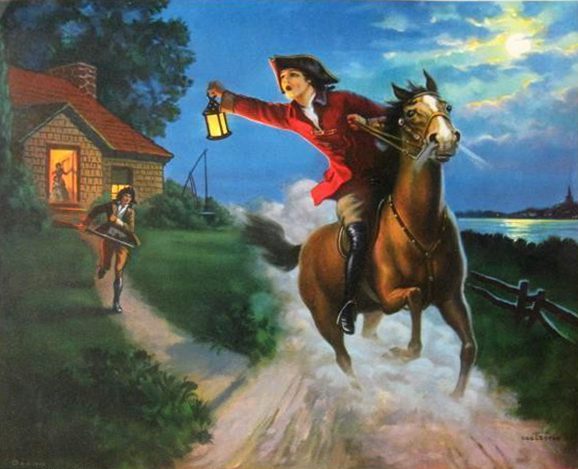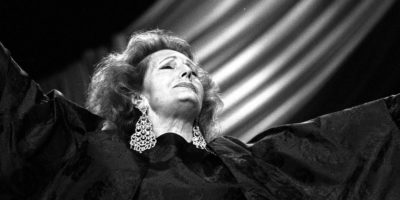Paul Revere: 15 Facts About the Legend
Paul Revere was a bell founder, silversmith, engraver, and American Revolutionary War hero. His nighttime ride to alert the colonists of the approaching British army on April 18, 1775, is what made him most famous. It was one of the pivotal moments in the buildup to the American Revolution, which helped to inspire the American resistance to British authority.
Revere was a complicated person with many facets. He was an accomplished businessman, an accomplished artist, and a devoted patriot. Here are Paul Revere’s 15 most interesting facts.
1. Paul Revere was born in Boston, Massachusetts

Edward Mason Eggleston (1882-1941), Public domain, via Wikimedia Commons
On December 21, 1734, Paul Revere was born in Boston, Massachusetts. Apollos Rivoire, his father, was a French Huguenot who immigrated to Boston when he was just 13 years old. Deborah Hitchborn, Revere’s mother, was from a prominent Boston family. Revere, who eventually became the eldest son to survive, was the third of nine children. He was raised in Boston’s North End, where his father’s silversmith shop was.
2. His father fled religious persecution in France
Apollos Rivoire, the father of Paul Revere, was born in Riocaud, France, in the year 1702. He was a Huguenot, a Christian who practiced Protestantism. Huguenots were persecuted in France by the Catholic majority. Paul Revere was Apollos Rivoire’s new name once he immigrated to Boston, Massachusetts, in 1715. For centuries, France’s minority Huguenots suffered persecution. They were compelled to become Catholics or risk being exiled. Many Huguenots who had escaped France eventually landed in the American colonies.
Check out these top 15 facts about the American Revolution
3. Revere apprenticed under his father at the age 13

John Singleton Copley, Public domain, via Wikimedia Commons
At the age of 13, Paul Revere became a silversmith apprentice to his father, Paul Rivoire. At the age of 19, he finished his apprenticeship in 1754. Revere’s father was a proficient silversmith who passed on his trade skills to his son. One of the most significant silversmiths in American history, Paul Revere achieved prominence as a silversmith. He created many products, such as jewelry, bowls, candlesticks, and tea sets. His work is distinguished by its excellent craftsmanship and original designs.
4. He became a master silversmith in 1756
In 1756, Paul graduated as a master silversmith. This indicated that he had attained the high criteria set by the guild of silversmiths and was now qualified to work on his own. His father was also a skilled silversmith. Paul learned the craft from his father and went on to become a talented silversmith in his own right. He is known for producing high-caliber artwork with unique designs.
5. He was a member of the Sons of Liberty

KRLA Beat, CC BY-SA 4.0, via Wikimedia Commons
The Sons of Liberty was a covert revolutionary group established in Boston in 1765. Revere was a member of this group. In order to express their disapproval of British rule in the American colonies, the Sons of Liberty took part in a number of actions. Riots, protests, and boycotts were some of these actions. Paul was in charge of planning demonstrations and disseminating propaganda. Also, he was involved in organizing the Boston Tea Party, a well-known demonstration against British rule.
Click to read more on the 30 famous African Americans in history
6. He was one of the organizers of the Boston Tea Party in 1773
One of the key organizers of the Boston Tea Party, a well-known demonstration against British rule in 1773, was Paul. The British law known as the Tea Act, which granted the British East India Company a monopoly on the selling of tea in the American colonies, was the target of the Boston Tea Party.
Revere and a number of other colonists boarded three British ships in Boston Harbor on December 16, 1773, while posing as Mohawk Indians. Almost £10,000 worth of tea was destroyed when they dumped 342 chests of tea into the bay.
7. He was captured by the British during the Revolution

j_m_d_imagery, CC BY-SA 4.0, via Wikimedia Commons
During the American Revolution, Revere was taken prisoner by the British and held captive for several months. On April 19, 1775, he was arrested as he traveled to Lexington and Concord to alert the colonists of the approaching British troops. After being transported to Boston, Revere was questioned by British officers. Despite being charged with being a spy, he was ultimately freed. He did, however, spend several months under house arrest.
8. He served as a courier and messenger for the Continental Army
During the American Revolution, Paul Revere worked as a messenger and courier for the Continental Army. He was in charge of relaying communications between army commanders and soldiers. He was a spy as well, acquiring information about British army movements. Revere was a proficient rider who was well-known in the Boston region. He was well recognized for his ability to conceal secrets and move swiftly and easily.
What have been the long term effects of World War 2 on the American society
9. He was the subject of Henry Wadsworth Longfellow’s poem

Marina Medic, CC BY-SA 4.0, via Wikimedia Commons
A well-known poem describing Revere’s midnight ride on April 18, 1775, is “Paul Revere’s Ride” by Henry Wadsworth Longfellow (1861). Although the poem is a fictitious description of Revere’s ride, it is based on tales from historical sources. Revere’s ride is depicted in a dramatic and moving manner in Longfellow’s poem. It portrays the thrill and peril of the moment with vivid images and suspense. Both the poem’s literary beauty and its factual authenticity have received appreciation.
10. He was a successful businessman after the Revolution
Paul established a foundry, a rolling copper mill, and a hardware store. He made more than 900 church bells in his work. During the time he worked as a messenger and courier for the Continental Army, he developed his economic acumen.
He gained a solid understanding of the significance of logistics and supply chain management as a result of this experience. The inventiveness of Revere’s enterprises contributed to their success as well. He was constantly trying to find new methods to make his goods and services better.
11. He opened a hardware store, a foundry, and a rolling copper mill

Paul Revere, Public domain, via Wikimedia Commons
After the American Revolution, Paul Revere opened a hardware store, a foundry, and a rolling copper mill. He was an accomplished artisan and a cunning businessman whose enterprises were prosperous. Tools, nails, and hinges were among the many products for sale in Revere’s hardware store. He also offered imports like watches and clocks for sale. Cast iron items, including stoves and fireplaces, were made at his foundry. He made guns and other military equipment as well. And lastly, his rolling machine for copper generated copper sheets for a number of uses.
12. Paul produced more than 900 church bells
Paul was an expert bell maker. His bells were well-known for their excellence and exquisite sound. The bell factory was situated in Boston, Massachusetts. He founded the foundry in 1792, and it ran until 1828. Revere made bells for churches all around the country at that period. Copper and tin were used to create Revere’s bells. They were hand-hammered into shape after being cast in molds. The bells were then embellished with elaborate patterns.
These are 20 most famous American politicians who were assassinated
13. He was a skilled artist and engraver

Hy Hintermeister (This could be by either John Henry Hintermeister 91869-1945) or his son Henry Hintermeister (1897-1970). Neither the copyright register nor the signature gives a clue which painter made the work.), Public domain, via Wikimedia Commons
Paul Revere was a talented engraver and artist. He was self-taught. He also picked up his talents by observing other engravers and artists at work. Furthermore, he was well recognized for his intricate engravings, many of which featured political or historical allegories. Historical events were recorded in Revere’s engravings. He created a number of engravings that showed the Battle of Lexington and Concord, the Boston Tea Party, and the Boston Massacre.
14. He was a member of the Massachusetts General Court
From 1776 through 1789, Revere served in the Massachusetts General Court. Massachusetts’ colonial legislature was known as the Massachusetts General Court. It was in charge of establishing laws and overseeing the colony. Revere was an outspoken advocate of the American Revolution while serving in the court. The Massachusetts Constitution, which was enacted in 1780, was also drafted with his assistance.
15. Paul died on May 10, 1818

Rhododendrites, CC BY-SA 4.0, via Wikimedia Commons
On May 10, 1818, Paul Revere passed away at the age of 83. He was laid to rest in Boston’s Granary Burying Ground. Boston’s community suffered a great loss as a result of Revere’s passing. He was well-known as a successful businessman, a gifted artist, and a devoted patriot. He is a key individual in American history to this day.
Paul Revere was an accomplished businessman, an artist, and a devoted patriot. One of the most well-known incidents in American history is his midnight ride on April 18, 1775, which inspired the country’s resistance to British control. The legacy of Revere is one of valor, loyalty, and inventiveness. He is remembered for the many marks he left behind.
Planning a trip to Paris ? Get ready !
These are Amazon’s best-selling travel products that you may need for coming to Paris.
Bookstore
- The best travel book : Rick Steves – Paris 2023 – Learn more here
- Fodor’s Paris 2024 – Learn more here
Travel Gear
- Venture Pal Lightweight Backpack – Learn more here
- Samsonite Winfield 2 28″ Luggage – Learn more here
- Swig Savvy’s Stainless Steel Insulated Water Bottle – Learn more here
Check Amazon’s best-seller list for the most popular travel accessories. We sometimes read this list just to find out what new travel products people are buying.









